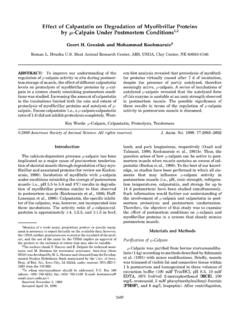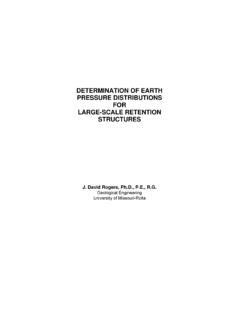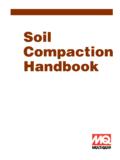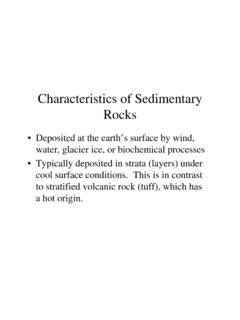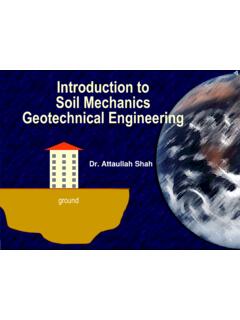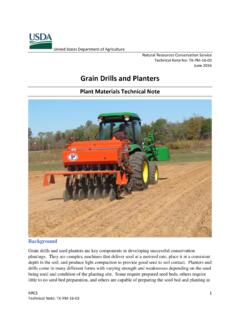Transcription of Soil Compaction: Where, How Bad, What to Do?
1 1 soil Compaction: where , how bad , what to Do?Ken SudduthAg EngineerUSDA Agricultural Research ServiceColumbia, MOSoil Compaction: where , how bad , what to Do? what is compaction ? what causes it? what are some of the effects? How can we measure compaction ? How can we manage compaction ? soil Compaction: where , how bad , what to Do?Thanks to the following for providing some of the slides and data used in this presentation: Dr. Randy Raper, Ag Engineer, USDA-ARS National soil Dynamics Lab, Auburn, Alabama Dr. Peter Motavalli, Associate Professor, soil , Environmental, and Atmospheric Sciences, University of MissouriWhat is compaction ? compaction is simply a reduction in pore spaceComposition of the soil VolumeComposition of the soil Volume Bulk density (Bulk density ( bb))= = MMss//VVtt Particle density Particle density (( ss))= M= Mss/V/Vss Porosity = Porosity = VVff/V/Vtt= = 1 1 --(( bb// ss)) compaction Definitions soil compaction Decrease in soil volume and porosity, or increase in soil bulk density, due to mechanical stress on soil , for example, from traffic of agricultural machinery.
2 compaction can also occur naturally. Surface compaction compaction that occurs in the surface plow layer Subsoil compaction compaction that occurs below the plow layer due to a surface Causes compaction ?Causes of compaction Vehicle TrafficVehicle Traffic0100002000030000400005000060000 Weight, TrafficFactors in Vehicle compaction Weak soil Moisture Content Effect Density EffectFactors in Vehicle compaction Weak soil Excessive Loads Size of Load at the Surface Ground Pressure3 Factors in Vehicle compaction Weak soil Excessive Loads Severity of Load atthe Surface Impact at Depth For equal stress at the surface, larger tires affect soil to a greater depth Vehicles have gotten larger!
3 Factors in Vehicle compaction Weak soil Excessive Loads Severity of Load at the Surface Impact at Depth Repeated Loadings First pass does 80% of total compaction Repeated loadings increase compaction Controlled traffic / AutoguidanceCauses of compaction Vehicle Traffic Natural soil ReconsolidationSoil Particle Sizes Clay (< mm) Silt ( mm) Sand ( - 2 mm)Basketballs, Baseballs, and MarblesSand and SiltSand and SiltSand and Silt and ClaySand and Silt and ClayHardpan ProfileTopsoilTopsoilSubsoilSubsoilHardp anHardpan4 Causes of compaction Vehicle Traffic Natural soil Reconsolidation Well-graded soils more susceptible to natural compaction than poorly- graded Diameter, mmPercent FinerPoorly-GradedWell-GradedWhat are Some Effects of compaction ?
4 Effects of compaction Increased soil ErosionEffects of compaction Increased soil Erosion Decreased InfiltrationEffects of compaction Increased soil Erosion Decreased Infiltration Decreased Water StorageSubsoiledSubsoiledCompactedCompac tedEffects of compaction Increased soil Erosion Decreased Infiltration Decreased Water Storage Reduced N UptakeCompactedNon-compacted5 Effects of compaction Increased soil Erosion Decreased Infiltration Decreased Water Storage Reduced N Uptake Decreased Root GrowthEffects of compaction Increased soil Erosion Decreased Infiltration Decreased Water Storage Reduced N Uptake Decreased Root Growth REDUCED YIELDE ffects of compaction on YieldTurkey litter (dry Mg ha-1)Corngrain yield (Mg ha-1) compacted ( )Corn Grain Yields, 2000 Corn Grain Yields, 2000 Data collected at MU Bradford Farm (Columbia) by Motavalli et of compaction on YieldPoultry litter (dry Mg ha-1)Corngrain yield (Mg ha-1) CompactedSubsoil 0610 20 NSLSD( )Corn Grain Yields, 2000 Corn Grain Yields, 2000 Data collected at MU Delta Center (Portageville) by Motavalli et and Site-Specific Management what is most often the major cause of within-field variation in crop productivity?
5 It s the water! soil and landscape factors that affect plant water availability are often the major causes of within-field yield variability. soil water holding capacity Redistribution of water over landscapes Ability of roots to extract water compaction affects all of theseIt s the water !6 How can we measure compaction ?Measuring compaction Directly: Change in soil volume Porosity Bulk densityMeasuring compaction Bulk density Time consuming Difficult to compare across soil typesMeasuring compaction soil cone penetrometer Measures the resistance of the soil to vertical insertion of a cone Cone Index (CI) in units of pressure psior MPa Standardized by ASABE (American Society of Agricultural and Biological Engineers)
6 To allow data comparison between devices/locations Difficult to get consistent readings with handheld, human-powered unitsMeasuring compaction soil cone penetrometer Human-powered units with electronic data collection are more useful, but pushing them into the ground at a consistent speed can still be difficult01234CI , MPa806040200 Depth, cmF1-101 ABt1Bt2C1 Data from a greenhouse study by Motavalli et al. using different Missouri soilsCompactionvs. YieldUsing PenetrometerMeasurementsBulk density (Mg m-3) Aboveground soil Bulk DensityPenetrometer resistance (MPa) Abovegroung Penetrometer resistanceY = - + - = **, n = 11 Sandy loam LoamClay loamY = - = *, n = 11 When BD < Mg m-3 then Y = + BD > Mg m-3 then Y = + vs.
7 Yield10203040 Depth to Maximum Cone Index, cm-2-10123 Standardized Soybean YieldCropping SystemMin-Till Corn-SoybeanNo-Till Corn-SoybeanNo-Till Corn-Soybean-Wheat01234CI , MPa806040200 Depth, cmF1-101 ABt1Bt2C1 compaction vs. Yield01234CI , MPa806040200 Depth, Cone Index, MPa-2-10123 Standardized Soybean YieldCropping SystemMin-Till Corn-SoybeanNo-Till Corn-SoybeanNo-Till Corn-Soybean-WheatMeasuring compaction soil cone penetrometer Automated units use a power source to push them into the soil and record data simultaneously Trailer-mounted Tractor-mounted Improved data collection But still a point measurementWithin-Field VariationSite 1 Site 2 Site 3 Within-Field Variation Using a penetrometer.
8 It s difficult to collect enough data to understand how compaction varies across fields Tillage draft sensors can collect surface compaction -related data on whole fields, but don t indicate depth variationsA New compaction Sensing Approach Desirable characteristics for a compaction sensor Rapid, efficient data collection at the intensity needed for spatial within-field compaction mapping ( on-the-go) Describe compaction profile to identify the depth of restrictive layers Repeatable, consistent measurements One solution: Tractor-mounted shank that collects soil strength data at multiple depths8 soil Strength Sensors USDA-ARS, Auburn, AL (Raper et al.)
9 On-the-go soil Strength Sensor (OSSS) One sensor tip, moves up and down University of Nebraska (Adamchuk et al.) Integrated soil Physical Properties Mapping System (ISPPMS) Blade-based sensor, measures total force and depth trendSoil Strength Sensors University of California (Upadhyaya et al.) compaction Profile Sensor (CPS) Five sensor tips to 40 cm depth USDA-ARS, Columbia, MO (Sudduth et al.) soil Strength Profile Sensor (SSPS) Five sensor tips to 50 cm depth20 tipMain bladeLoad cell* Width is 1 in. with cover onAB* A: tip extension (2 in.)* B: tip spacing (4 in.)USDA-MO SSPS 5 extended sensing tipsUSDA-MO SSPS Field Test ResultsDepth=10 cmDepth=30 cmDepth=20 cmDepth=50 cmDepth=40 cm160170180190200210 Position, m01234 PSSI, MPa Sensor worked well in field tests, showing both short-range and longer-scale variations in soil compactionCompaction Mapping10 cm20 cm30 cm40 cm50 (MPa)How can we manage compaction ?
10 Avoiding compaction Undoing Compaction9 Avoiding compaction Reduced Axle Load Near surface compaction caused by specific pressure Subsoil compaction caused by axle loadAvoiding compaction : Research Results Assuming moist, arable soil : tons/axle compacts to 12 in. tons/axle compacts to 16 in. 11 tons/axle compacts to 20 in. tons/axle compacts to 24 in. and deeper It s common to see subsoil compaction persist for 6-7 , and Reeder, 1994 Approximate Axle Loads35(rear)13 (front)Double dual-axle 50 yd3manure tanker (full)22 Single axle 27 yd3grain cart (full)2612-row combine (full)116-row combine (empty)9320 hp 4-wheel drive tractor8200 hp 2-wheel drive tractor4100 hp 2-wheel drive tractorAxle Load(ton/axle)Equipment Reduced Axle Load Minimize Tractive Element-Tire Contact Stress (Spread the Load)




